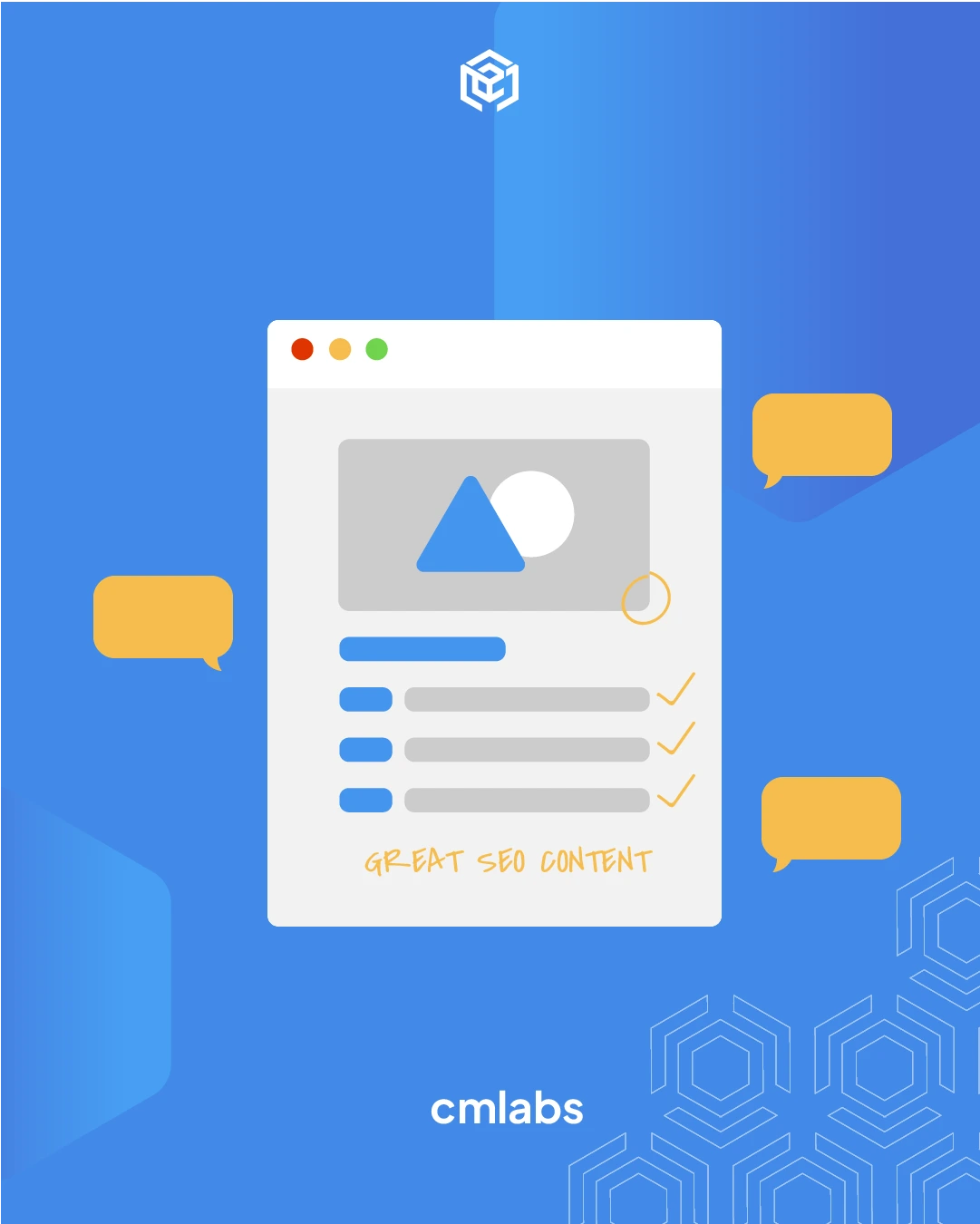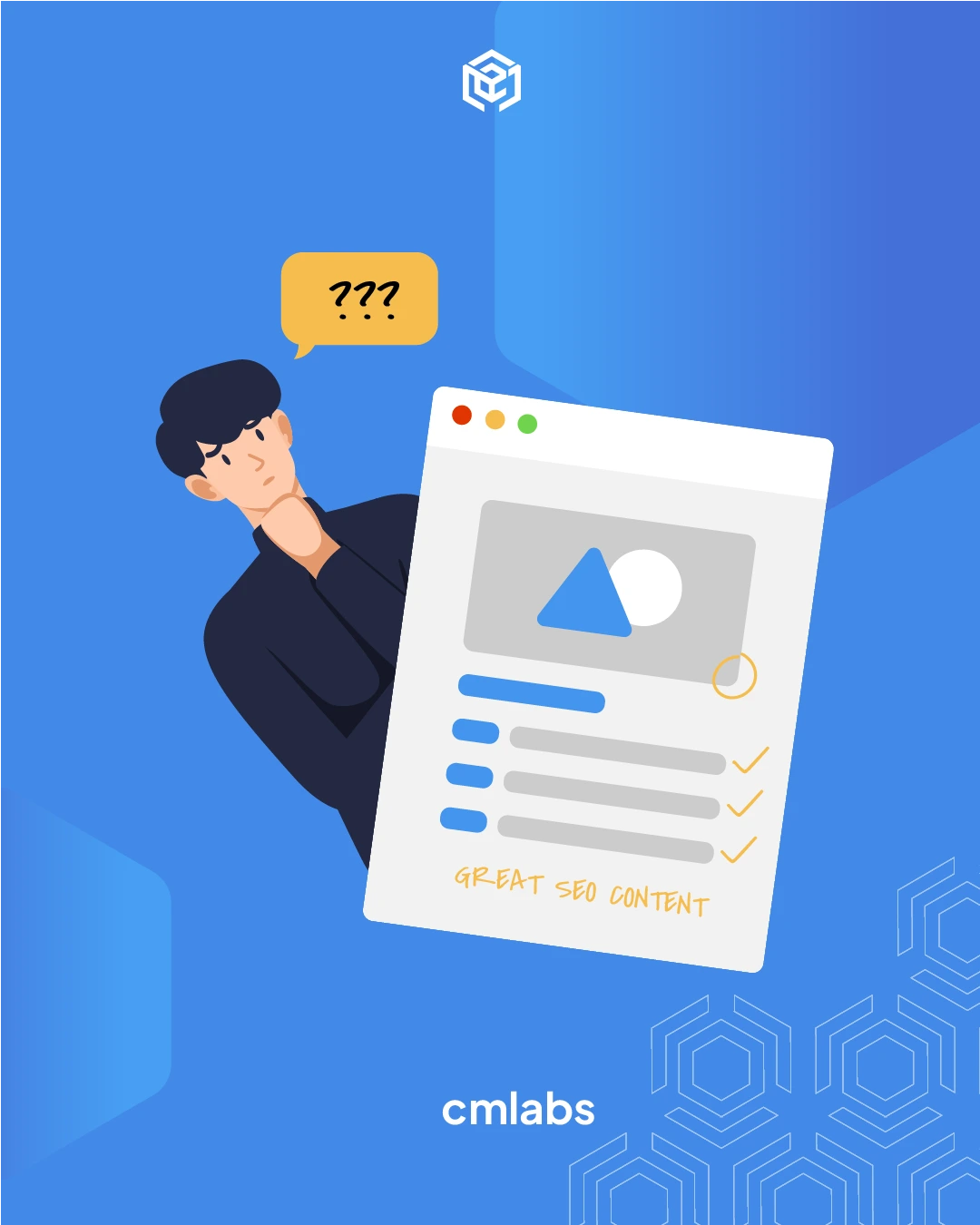We use cookies
This site uses cookies from cmlabs to deliver and enhance the quality of its services and to analyze traffic..
SEO SERVICES
Conduct in-depth technical website audits, strategically develop website projections, and increase your website authority.
ASO SERVICES
Elevate Your App’s Presence with Our Expert ASO Services – Boost Visibility and Drive Downloads!
WRITING SERVICES
We offer a variety of writing services to suit different business necessities. Reach broader audiences or lead specific industries? We've got you covered!
Get relevantly positive media exposure from bloggers and online publishers to increase your brand mentions on search engine results pages.
SEOlutions
A unified source of truth!
SEO & Digital Maternity Solution
SEO & Digital Maternity Solution: Leverage Cross-Platform Insights to Elevate Your Strategy with Expert Consultation
SEO & Digital Maternity Solution
Data Solution options:
Starting from Rp200 mio
Reinventing how a company get creative treatments
A new way to get your creative needs done. Agile team, efficient cost, and expedient way in a flexible yet scalable subscription plan!
Creative-as-a-Services
CaaS package options:
Based on Subscription
Pioneer in digital marketing software powerhouse
We’re excited to unveil our new range of Tech Solutions designed to drive your digital success. Whether you’re looking to enhance your website’s performance, streamline your tech stack, or unlock deeper insights from your data, we’ve got you covered.
Starting from Rp250 mio
Our Clients
Research and innovation center for digital transformation
Digital marketing combines technical skills and business knowledge at every stage. For marketing teams, improving budget management efficiency is crucial, as time is an invaluable resource that should be used wisely. At Sequence, we are dedicated to empowering you to optimize efficiency and strategic planning, ultimately enhancing the impact of your digital marketing efforts.
Subscription-based (IDR1,800/keyword)
Our Clients
BeyondSEO
References
SEO Tools for Webmasters
SEO Tools for Writers
SEO Tools
FIND THE SUITABLE PARTNERSHIP FOR YOUR COMPANY
Check out which cmlabs partnership program suits your company
WHITE LABEL SEO
for CorporateYour company is granted exclusive partnership rights to provide SEO services to our important clients, and we will provide a dedicated backend team to support your efforts.
AFFILIATE PROGRAM
for BizdevA new affiliate program is being introduced for skilled marketers and individuals with strong networks, offering commissions of up to 7% for generating profits independently.
DIGITAL AGENCY
for Marketing Partnerscmlabs is an essential partner for digital agencies, providing a unique selling proposition in Search Engine Optimization (SEO).
BACKLINK PARTNERSHIP
for Media / BloggerWe have a vast database of bloggers and media outlets across Indonesia, categorized by region and media type, giving our clients an edge in managing their media and SEO activities.
OFFICIAL TRAINING
We provide ongoing professional development and support to SEO professionals to ensure they are equipped to meet market demands.
JOIN AS CONTRIBUTOR
for Content WriterGreat opportunity for SEO Writers around the world. T&C applied!
ACADEMIC PARTNERSHIP
Through partnerships with universities in Indonesia, cmlabs has helped align academic curricula with industry demands.
Partnership
Sector & Industries
Tell us your SEO needs, our marketing team will help you find the best solution
As an alternative, you can schedule a conference call with our team
Schedule a Meeting?Contact
Survey
We use cookies
This site uses cookies from cmlabs to deliver and enhance the quality of its services and to analyze traffic..
Last updated: Jan 02, 2025

Index Coverage Report is a report feature provided by Google Search Console to provide information to webmasters about the indexing process by Google.
In addition, this report also displays the status of each page that has been visited or accessed by Google bots.
In its display, each page is grouped based on certain statuses. Whether it's pages that have been validated and added to the index, pages that are excluded from the index, pages with major problems, and also pages with warnings.
In general, this report is here to help you monitor and understand the indexation status of each website page by Google. The complete functions are as follows:
Here's how to use the Index Coverage Report to improve website performance and visibility:
In the Index Coverage Report, several types of issues are commonly reported related to the indexation of pages on the website. Check out the details below:
When Google bots find a page but cannot index it due to the "No index" tag in the HTTP response, this can reduce the visibility and accessibility of your content in search results.
This issue usually arises when you block a URL using Google's page removal tool. Keep in mind that this method is only temporarily effective. It takes 90 days for Google to show the URL in search results again.
You need to monitor this section regularly because Google will have difficulty indexing pages with server errors (Status Code 5xx).
If a server error occurs, you may need to contact the server administrator to fix it or check if the error was caused by an update to the site.
A redirect error indicates that the redirect you set up was unsuccessful, so it does not transfer search engine bots and users from the old URL to the new one.
This kind of error is usually triggered by poor redirect configuration, such as the use of redirect chains or looping.
Blocking by robots.txt is also one of the problems in the Index Coverage Report.
If the website page is blocked by the robots.txt file, then you don't need to worry. Because the page can still be indexed in other ways (although the chances are small), especially if Google manages to find other information about the web page.
If you want to make sure that the page is not indexed by Google, then remove the robots.txt blocking and use the 'noindex' command.
Indicates access to the page requires login with a valid user ID and password.
To resolve this issue, you need to remove the authorization requirement or verify the Google bot to be able to access the page again.
This indicates that Google bots have crawled the page URL, but are still considering whether the page should be indexed in search results or not.
This could be due to various factors, such as content quality, relevance, or indexing settings.
In some cases, this may indicate that Google will index it soon, or it could be related to an indexing budget issue where Google considers your website to be of low quality.
You need to make sure that every alternative page on your site has the correct canonical tag to point Google to the main version of the page.
The goal is to ensure that your content is indexed correctly and there is no duplication in search results.
You can use the URL inspection tool by Google, for instance, to find out which URLs are selected by Google as canonical. With the tool, you can easily identify the main version of the page accepted by Google as a reference.
When you select a page as canonical, Google sometimes selects another page as the canonical version, especially if the page you want as canonical is less internally connected than the non-canonical page.
A 404 error page shows that the requested page cannot be found because it has been changed or deleted.
Therefore, you should prioritize resolving this issue as it can affect user experience and also damage your website's reputation.
A page with the status "Page with redirect" implies that the page has been redirected, so it is not yet indexed by Google.
When you do a permanent redirect for a page, make sure you apply a 301 redirect to an alternative page that is still relevant.
The Soft 404 problem occurs when a website returns a 200 status code indicating that the page exists, but the content shows errors or is not relevant.
This status code 403 means that the server accepted the request, but refused to grant access permission. Here are the steps to deal with this issue:
WDYT, you like my article?
Couldn't find result for "Mulki" try to search with different keyword
Suggestion:
Tell us your SEO needs, our marketing team will help you find the best solution
As an alternative, you can schedule a conference call with our team
Schedule a Meeting?



cmlabs Jakarta Jl. Pluit Kencana Raya No.63, Pluit, Penjaringan, Jakarta Utara, DKI Jakarta, 14450, Indonesia
(+62) 21-666-04470These strategic alliances allow us to offer our clients a wider range of SEO innovative solutions and exceptional service.

Psst! Hey there, SEO Stats and Tools SEO company! If you've ever planned of conquering the Indonesia market, you've come to the right place!